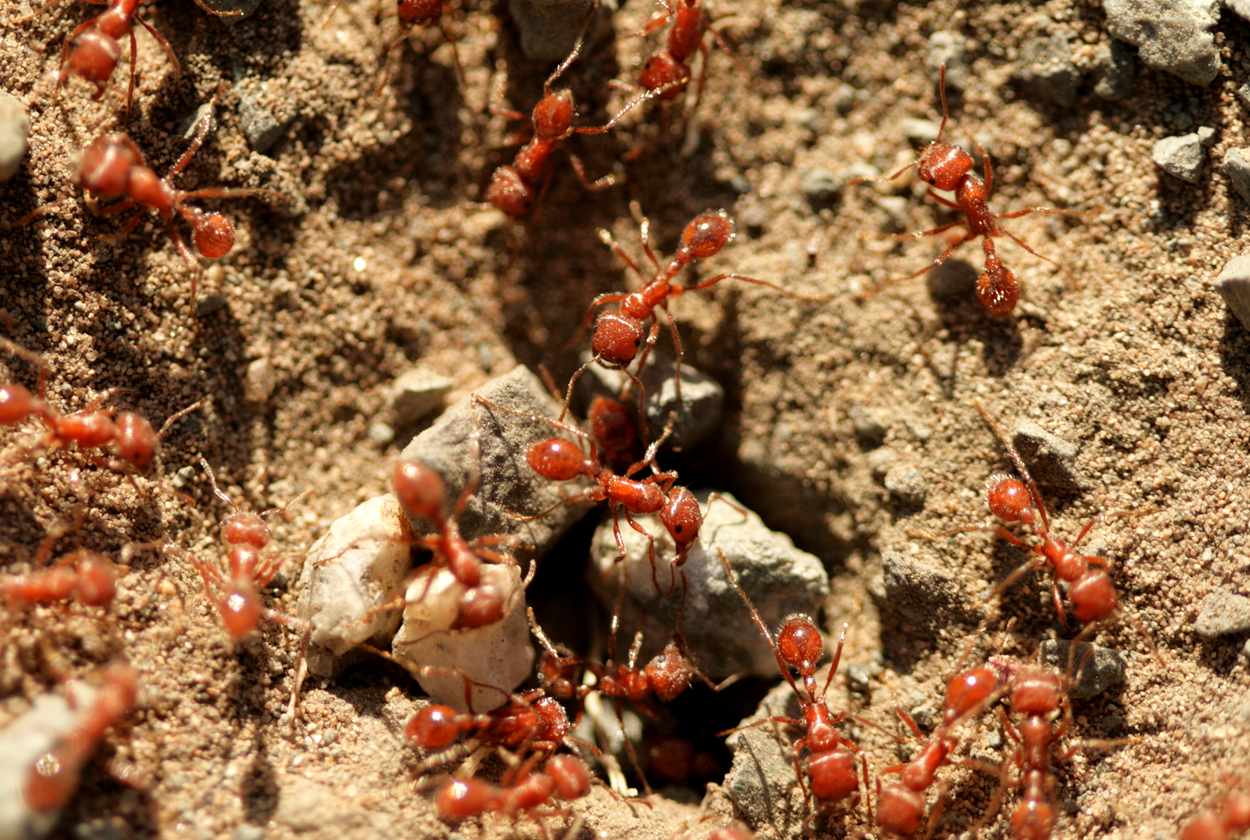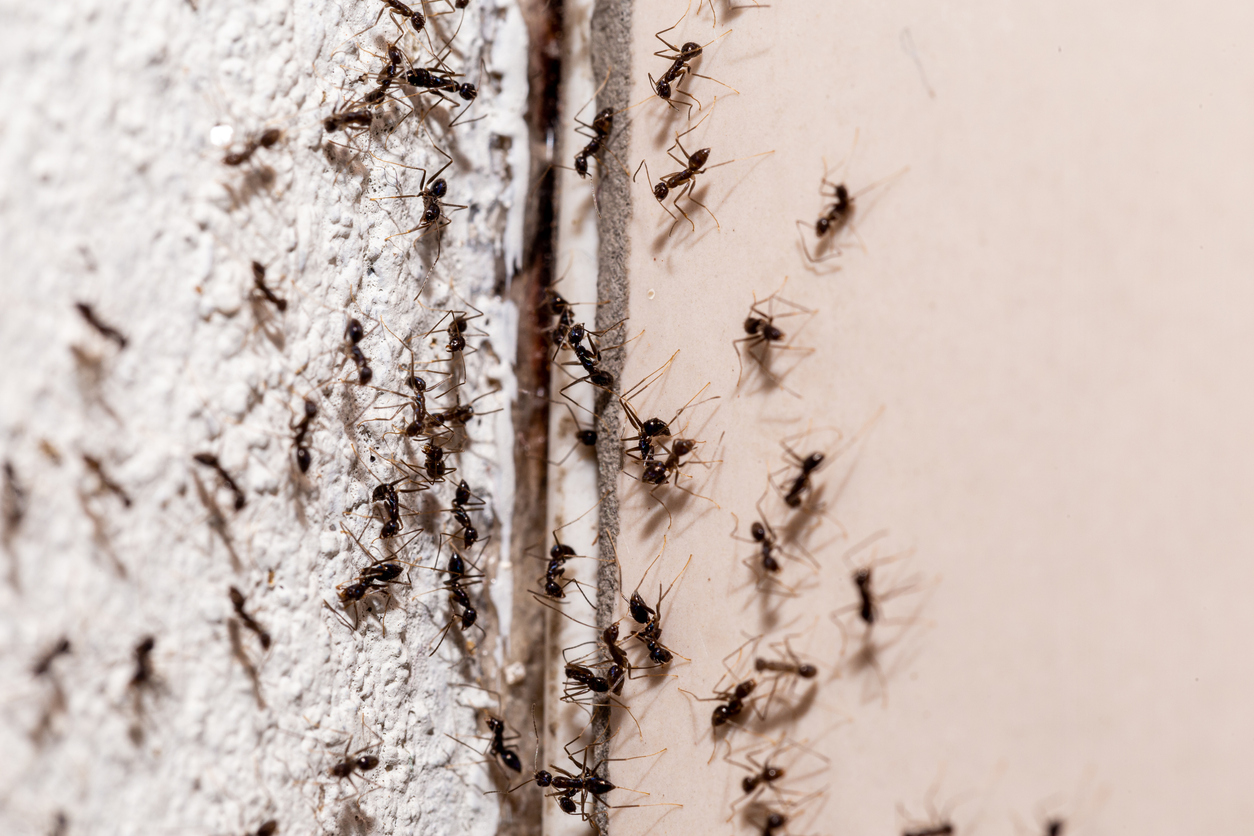Fire Ants
Common Pest: Fire Ants
Fire ants have been listed as one of the top 100 world’s worst invasive species. The generic name “fire ants” encompasses several species in the genus Solenopsis, but most commonly refers to the Solenopsis invicta.
This species is the nastiest of all the ant species. Fire ants are not native to the United States, but were imported in the early 1900s and have since spread rapidly. Their swift overtaking of the southern states is due in part to their rapid rate of reproduction. One queen can produce numerous eggs and quickly populate an entire nest. Also, fire ants are able to survive extreme conditions, making them resilient to climate and weather changes.
Identifying Fire Ants
Their coloring most readily identifies fire ants. They have a copper brown head and darker abdomen. Like most insects, fire ants possess three sections: head, thorax, and abdomen. They range in size from an eighth of an inch to a quarter of an inch long and have three pairs of legs. Also, two antennae protruding from their heads.
Fire Ant Behavior
Fire ants create large mounds in open, sunny areas to house their entire colony. They construct these mounds out of clay and dirt. Below the surface, a labyrinth of tunnels and passageways house the queen, larvae, and other ants. Jobs are assigned based on the ant’s size. The queen, typically the largest female ant, is responsible for reproduction and can produce up to 1,600 eggs per day. Worker ants maintain the nest, care for eggs, larvae, and pupae, and forage for food, while solider ants protect the colony from outside dangers. Male ants mate with the queen and then die immediately afterwards.
Fire ants are omnivores. They eat both meat and vegetation. Some of their favorite foods are meats, greasy tidbits, and sweet morsels. These ants are extremely aggressive and will kill small animals, then devour the carcass. In order to sting a person or animal, they will first bite for grip, then inject venom from their abdomen.
Identifying Fire Ants
Their coloring most readily identifies fire ants. They have a copper brown head and darker abdomen. Like most insects, fire ants possess three sections: head, thorax, and abdomen. They range in size from an eighth of an inch to a quarter of an inch long and have three pairs of legs. Also, two antennae protruding from their heads.
Fire Ant Behavior
Fire ants create large mounds in open, sunny areas to house their entire colony. They construct these mounds out of clay and dirt. Below the surface, a labyrinth of tunnels and passageways house the queen, larvae, and other ants. Jobs are assigned based on the ant’s size. The queen, typically the largest female ant, is responsible for reproduction and can produce up to 1,600 eggs per day. Worker ants maintain the nest, care for eggs, larvae, and pupae, and forage for food, while solider ants protect the colony from outside dangers. Male ants mate with the queen and then die immediately afterwards.
Fire ants are omnivores. They eat both meat and vegetation. Some of their favorite foods are meats, greasy tidbits, and sweet morsels. These ants are extremely aggressive and will kill small animals, then devour the carcass. In order to sting a person or animal, they will first bite for grip, then inject venom from their abdomen.
Signs of a Fire Ant Infestation
Most people realize they have a fire ant infestation when they notice the large, dirt ant mounds. Typically, these mounds reach seven inches tall and twenty-four inches in diameter. However, in dry climates, ants build more extensively underground and may have only a small mound on top. Giant mounds have also been found in rare circumstances. Each mound houses anywhere from 100,000 to 500,000 fire ants.
Fire ant sightings also indicate that there may be a larger fire ant problem looming nearby. Worker and swarmer ants venture outside of the colony to find food, water, and other supplies. The absolute worst way to find out about a fire ant influx is to be stung! This is often the time when people begin trying to eradicate the pest.

When Fire Ant Infestations are Most Likely to Occur
Although fire ants can survive the most extreme conditions, they still seek a milder environment. Typically, they seek a dry environment during rainy seasons. Many people believe they are driven into homes by rain. When they cannot easily survive the natural habitat because of flooding, they will move to higher, drier ground, and if necessary, or easily accessible, a home.
On the other hand, they also require water to live. In a drought, they will seek out additional water sources. Home and business owners often find them building nests close to water hoses, sprinklers, and other moist areas. Ants are more noticeable when they are on the move. They begin to invade personal space and become unwanted pests. After a population is exterminated, fire ants can return in as little as one month’s time and begin to repopulate.
When Fire Ant Infestations are Most Likely to Occur
Although fire ants can survive the most extreme conditions, they still seek a milder environment. Typically, they seek a dry environment during rainy seasons. Many people believe they are driven into homes by rain. When they cannot easily survive the natural habitat because of flooding, they will move to higher, drier ground, and if necessary, or easily accessible, a home.
On the other hand, they also require water to live. In a drought, they will seek out additional water sources. Home and business owners often find them building nests close to water hoses, sprinklers, and other moist areas. Ants are more noticeable when they are on the move. They begin to invade personal space and become unwanted pests. After a population is exterminated, fire ants can return in as little as one month’s time and begin to repopulate.
Problems Caused by Fire Ant Infestations
Left unchecked, fire ants can wreak havoc on your property, animals, home, and even you! While fire ant bites are painful, they are not lethal in most people. However, some people are highly allergic to the bites. Fire ants have also been known to kill small animals. Several species of wildlife are decreasing in numbers because of fire ant attacks. Farmers are losing money on livestock and crops that are struck. In Florida, fire ants have been known to assault and kill freshly planted citrus trees. Fire ants also enjoy building a nest in electrical and utility housings, causing short circuits and possibly fires.
How to Treat for Fire Ants
All home and business owners should regularly check their properties for signs of fire ant infestation. If you see any signs of fire ants, contact a professional right away for an estimate on controlling them. Left unchecked, these pests can take over your yard or home – and you do not want to share a habitat with these vicious pests.

St. Louis, Missouri
Email: scheduling@bugsbybrian.com
Call: (636) 394-0101
Location: 1401 Marsh Ave., Ellisville MO 63011
Melbourne, Florida
Email: scheduling@bugsbybrian.com
Call: (321) 674-1665
Location: 3830 S. Highway A1A Suite, 4135 Melbourne Beach, FL 32951
Ready to get started?
We offer free, no obligation estimates for all our pest control services.
Follow us on our social media plateforms


